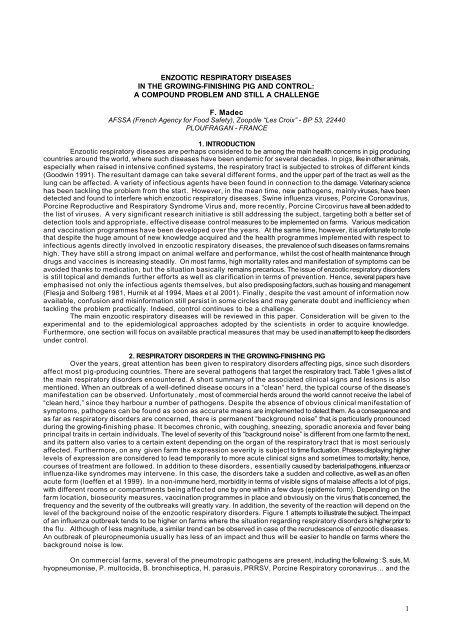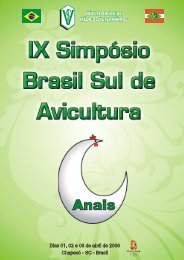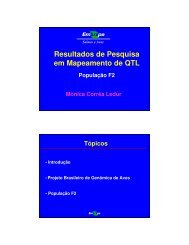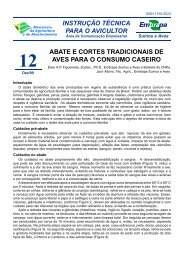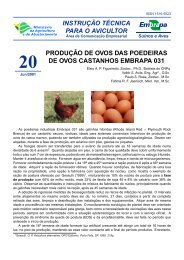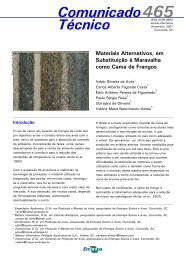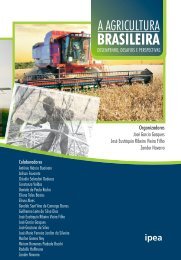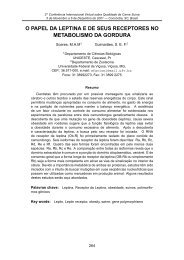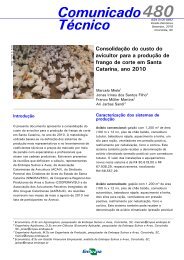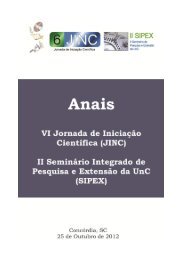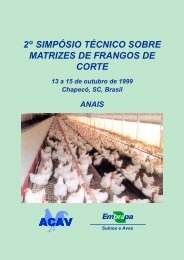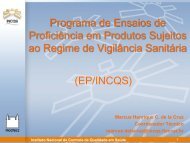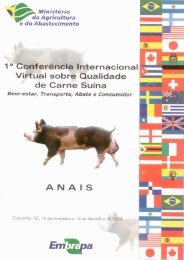enzootic respiratory diseases in the growing-finishing pig and control
enzootic respiratory diseases in the growing-finishing pig and control
enzootic respiratory diseases in the growing-finishing pig and control
You also want an ePaper? Increase the reach of your titles
YUMPU automatically turns print PDFs into web optimized ePapers that Google loves.
<strong>in</strong>fection pressure) <strong>in</strong> <strong>the</strong> different compartments of <strong>the</strong> herd, thus keep<strong>in</strong>g <strong>the</strong> pathogen load at an acceptable level iewith<strong>in</strong> herd immunity level, easy to h<strong>and</strong>le <strong>and</strong> f<strong>in</strong>ally, avoid disease expression.Although health would be easier to ma<strong>in</strong>ta<strong>in</strong> <strong>in</strong> <strong>the</strong> absence of <strong>in</strong>fection by specific pathogens, <strong>the</strong> presence ofthose associated with <strong>enzootic</strong> <strong>respiratory</strong> <strong>diseases</strong> is not <strong>in</strong>compatible with good levels of health <strong>and</strong> performance,provided that that adequate hous<strong>in</strong>g <strong>and</strong> herd management are provided.7. CONCLUSIONA vast amount of knowledge is available about <strong>enzootic</strong> <strong>respiratory</strong> disorders, <strong>and</strong> it is paradoxical that <strong>the</strong> lattershould rema<strong>in</strong> a major concern <strong>in</strong> modern <strong>in</strong>tensive <strong>pig</strong> farm<strong>in</strong>g. It is all <strong>the</strong> more surpris<strong>in</strong>g given that new technologiesare now available for both pathogen detection <strong>and</strong> disease prevention. This frustrat<strong>in</strong>g situation is probably , at least <strong>in</strong>part, due to <strong>the</strong> multifactorial character of <strong>the</strong> problem; <strong>the</strong> scientists <strong>in</strong>volved <strong>in</strong> different discipl<strong>in</strong>es <strong>in</strong> <strong>the</strong>ir labs often donot work <strong>and</strong> <strong>in</strong>tervene <strong>in</strong> direct collaboration with various advisers on <strong>the</strong> farms. A more <strong>in</strong>tegrated technical effort couldcerta<strong>in</strong>ly improve both <strong>the</strong> accuracy <strong>and</strong> <strong>the</strong> efficiency of <strong>the</strong> preventive programmes. The emphasis must be on reduc<strong>in</strong>g<strong>the</strong> overwhelm<strong>in</strong>g challenges to <strong>the</strong> <strong>pig</strong>’s immune status due to bacteria <strong>and</strong> viruses. In this area reliable clues arealready known. However, fur<strong>the</strong>r <strong>in</strong>vestigations should clarify certa<strong>in</strong> po<strong>in</strong>ts <strong>and</strong> respond to those currently -unansweredquestions: How to objectively assess <strong>the</strong> herd microbial load?; how to assess <strong>the</strong> dynamics of <strong>the</strong> pathogenic microflora<strong>in</strong> a herd ? what are <strong>the</strong> factors that trigger an outbreak of pleuropneumonia <strong>in</strong> a silently App <strong>in</strong>fected herd? Newscientific acquisitions <strong>in</strong> <strong>the</strong>se fields may help to underst<strong>and</strong> <strong>the</strong> reasons of disease expression. Def<strong>in</strong>itely <strong>the</strong>perspective of an effective prevention <strong>in</strong>itiative must <strong>in</strong>tegrate all discipl<strong>in</strong>es of animal sciences, <strong>in</strong>clud<strong>in</strong>g livestockbuild<strong>in</strong>g design <strong>and</strong> herd management.8. REFERENCES- AJITO T., HAGA Y., HOMMA S., GORYO M., DKADA K., 1996. Immunohistological evaluation of <strong>respiratory</strong> lesionsof <strong>pig</strong>s <strong>in</strong>tranasally <strong>in</strong>oculated with Act<strong>in</strong>obacillus pleuropneumoniae, serotype 1. J. of Vet. Red. Sci. 58, 297-303.- ALEXANDER T.J.L., 1980. Medicated earl wean<strong>in</strong>g to obta<strong>in</strong> <strong>pig</strong>s free from pathogens endemic <strong>in</strong> <strong>the</strong> herd of orig<strong>in</strong>.Vet. Rec. 106, 114-119.- AMASS S.E., CLARK L.K., VAN ALSTINE W.G., BOWERSOCK T.L., MURPHY D.A., KNOX K.E., ALBREGTS S.R.,1994. Interaction of Mycoplasma hyopneumoniae <strong>and</strong> Pasteurella multocida <strong>in</strong>fections <strong>in</strong> sw<strong>in</strong>e. J. Am. Vet. Med.Assoc. 204, 102-107.- AMASS S.F., CLARK L.K., 1999. Biosecurity considerations for pork production units. Sw<strong>in</strong>e Health <strong>and</strong> Production7, 217-228.- ANDREASEN M., BAEKBO P., NIELSEN J.P., 1999. Effects of aerial ammonia on Porc<strong>in</strong>e <strong>in</strong>fection of <strong>the</strong><strong>respiratory</strong> tract with toxigenic Pasteurella multocida. Acta Veter<strong>in</strong>aria Sc<strong>and</strong><strong>in</strong>avica 40, 197-203.- ARTIUSHIN S., MINION F.C. 1996 Arbitrarily primed PCR analysis of M. hyopneumoniae field isolatesdemonstrates genetic heterogeneity . Intern.J. of systematic Bacteriology 46, 324 –328- BASKERVILLE A. 1972. Development of <strong>the</strong> early lesions <strong>in</strong> experimental <strong>enzootic</strong> Pneumonia of <strong>the</strong> <strong>pig</strong> : anultrastructural <strong>and</strong> histological study. Res. Vet. Sei. 13, 570-578- BLAHA T. 1992 Proceed<strong>in</strong>gs 12th IPVS congress, <strong>the</strong> Hague, PP 126- BLANCHARD B., VENA M.M., CAVALIER A., LE LANNIC J., GOURANTON J., KOBISCH M.,1992. Electronmicroscopic observation of <strong>the</strong> <strong>respiratory</strong> tract of SPF <strong>pig</strong>lets <strong>in</strong>oculated with Mycoplasma hyopneumonsae. Vet.Microbiol. 30, 329-341- CARUSO J.P., ROSS R.E., 1990. Effects of Mycoplasma hyopneumoniae <strong>and</strong> Act<strong>in</strong>obacillus pleuropneumoniae<strong>in</strong>fections on alveolar macrophage functions <strong>in</strong> sw<strong>in</strong>e. Am. J. Vet. Res. 51, 227-231.- CIPRIAN A., PISOAN C., CRUZ T., CAMACHO J., TORTORA J., COLMENARES G., LOPEZ-REVILLA R., DE LAGARZA M. 1998. Mycoplasma hyopneumoniae <strong>in</strong>creases <strong>the</strong> susceptibillity of <strong>pig</strong>s to experimental Pasteurellamultocida pneumonia. Can. J. Vet. Res. 52, 434-438.- DEE S., 1999. Bacterial <strong>respiratory</strong> <strong>diseases</strong> of nursery <strong>pig</strong>s. Compendium on Conti. Educ. for <strong>the</strong> pract. Vet. 21,5170-5176.- DESROSIERS R., MOORE C., 1998. Indirect transmission of Act<strong>in</strong>obacillus pleuropneumoniae. Sw<strong>in</strong>e Health <strong>and</strong>Production 6, 263-265.- DIEKMAN M.A., SCHEIDT A.B., SUTTON A.L., GREEN M.L., CLAPPER J.A., KELLY D.T., VAN ALSTINE W.G.,1993. Growth <strong>and</strong> reproductive performance, dur<strong>in</strong>g exposure to ammonia, of gilts afflicted with pneumonia <strong>and</strong>rh<strong>in</strong>itis. Am. J. Vet. Res. 54, 2128-2131.- DONE S. 1991 pneumonia, some aspects of treatment <strong>and</strong> <strong>control</strong>. Pig Vet. J. 27, 30-49.- DRUMMOND J.G., CURTIS S.E., MEYER R.C., 1981. Effects of atmospheric ammonia on young <strong>pig</strong>sexperimentally <strong>in</strong>fected with Bordetalla bronchiseptica. Am. J. Vet. Res. 42, 963-968.5
- DRUMMOND J.G., CURTIS S.E., SIMON J., 1978. Effects of atmospheric ammonia on bacterial clearance <strong>in</strong> <strong>the</strong>young <strong>pig</strong>. Am. J. Vet. Res. 39, 211-212.- FLESJA K.I., SOLBERG I.1981. Pathological lesions <strong>in</strong> sw<strong>in</strong>e at slaughter. Acta Vet. Sc<strong>and</strong>., 22, 272-282- GOODWIN RFW 1991. Cl<strong>in</strong>ical <strong>and</strong> Epidemiological aspects of <strong>respiratory</strong> disease <strong>in</strong> <strong>pig</strong>s. Proceed<strong>in</strong>gs RoyalVer./Pfizer Ltd symposium, Royal Vet. College, July 1991, pp.47-52- GUZYLACK S., MORVAN P., PABOEUF F., LABBE A., CHEVALLIER B., KOBISCH M., MADEC F., 1997. Infectiondes porcs charcutiers par Act<strong>in</strong>obacillus pleuropneumoniae. Etude séro-épidémiologique dans 5 élevages. J. Rech.Porc<strong>in</strong>e 29, 31-38.- HALL W.F., BANE D.P., KILROY C. R., ESSEX-SORLIE D.L., 1990. A model for <strong>the</strong> <strong>in</strong>duction of Pasteurellamultocida type A pneumonia <strong>in</strong> <strong>pig</strong>s. Can. J. Vet. Res. 54, 238-243.- HURNIK D.,DOHOO I.R., BATE L.A., 1994 . Types of farm management as risk factors for sw<strong>in</strong>e <strong>respiratory</strong>disease. Prev. Vet. Red. 20, 147-157- JERICHO KWF 1968. Pathogenesis of pneumonia <strong>in</strong> <strong>pig</strong>s. The Vet. Record 82, 507.- JOBERT J.L., SAVOYE C., CARIOLET R., KOBISCH M., MADEC F., 2000. Experimental aerosol transmission of A.pleuropneumoniae to <strong>pig</strong>s. Can. J. Vet. Res., 64, 21-26.- JOLIE R., BACKSTROM L., OLSON L., CHASE C., 1999. A 15-week experimental exposure of <strong>pig</strong>s to airborne dustwith added endotox<strong>in</strong> <strong>in</strong> a cont<strong>in</strong>uous flow exposure chamber. Can. J. Vet. Res. 63, 129-137.- KOBISCH M., BLANCHARD B., LE POTIER M.F., 1993. Mycoplasma hyopneumoniae <strong>in</strong>fection <strong>in</strong> <strong>pig</strong>s : duration of<strong>the</strong> disease <strong>and</strong> resistance to re<strong>in</strong>fection. Vet. Res. 24, 67-77.- KOVACS F., NAGY A., SALLAI J., 1967. Concentrations of dust, airborne bacteria <strong>and</strong> ammonia <strong>in</strong> <strong>pig</strong> hous<strong>in</strong>g <strong>and</strong><strong>the</strong>ir relationship to <strong>the</strong> <strong>in</strong>cidence of pneumonia. Magyar Allotorvosok Lapja, 22, 496-505.- LARSEN I.P., 1998. Danish SPF herds: a lesson <strong>in</strong> precautions. Pig progress, June 1998, 46-47.- LARSSON K., EKLUND A.G., HANSSON L.O., I. SAKSSON B.M., MALMBERG P.O., 1994. Sw<strong>in</strong>e dust causes<strong>in</strong>tense airways <strong>in</strong>flammation <strong>in</strong> healthy subjects. Am. J. Respir. Crit. Care Med., 150, 973-977.- LAVAL A., 1995. Respiratory <strong>diseases</strong>, vacc<strong>in</strong>ation pr<strong>in</strong>ciples: what strategy should be adopted? When <strong>and</strong> how touse vacc<strong>in</strong>es? Pigs-Misset June 1995, 28-29.- LEON E.A, MADEC F., TAYOR N.M., KOBISCH M., 2001. Seroepidemiology of Mycoplasma hyopneumoniae <strong>in</strong><strong>pig</strong>s from farrow-to-f<strong>in</strong>ish farms. Vet. Microbiol. 78, 331-341.- MADEC F., KOBISCH M., LEFORBAN Y., 1993. An attempt at measur<strong>in</strong>g health <strong>in</strong> nucleus <strong>and</strong> multiplier <strong>pig</strong> farms.Livest. Prod. Sci. 34, 281-294.- MADEC F., TILLON J.P., 1986. The ecopathological approach <strong>in</strong> <strong>pig</strong> veter<strong>in</strong>ary practice. Its application to <strong>the</strong> <strong>control</strong>of <strong>enzootic</strong> <strong>respiratory</strong> <strong>diseases</strong> <strong>in</strong> <strong>in</strong>tensive <strong>pig</strong>s units. Proceed<strong>in</strong>gs <strong>pig</strong> Vet. Soc. 15, 7-26.- MAES D.G., DELUYKER H., VERDONCK M., CASTRYCK F., MIRY C., VRIJENS B., DUCATELLE R., DE KRUIFA. Non- <strong>in</strong>fections factors associated with macroscopic <strong>and</strong> microscopic lung lesions <strong>in</strong> slaughter <strong>pig</strong>s from farrowto-f<strong>in</strong>ish herds. The Vet. Rec. 148, 41-46- MEBUS CA., UNDERDAHL NR, 1977. Scann<strong>in</strong>g electron microscopy trachea <strong>and</strong> bronchi from gnotobiotic <strong>pig</strong>s<strong>in</strong>oculated with Mycoplasma hyopneumoniae. Am. J. Vet. Res. 38, 1249-1254.- ROBERTSON J.F., 1993. Dust <strong>and</strong> ammonia concentrations <strong>in</strong> <strong>pig</strong> hous<strong>in</strong>g: <strong>the</strong> need to reduce maximum exposurelimits. Livest. Environment Ivth Intern. Symp. Univ. of Warrick, Coventry, Engl<strong>and</strong> 6-9 July 1993, 4, 694-700.- SCHEIDT A.B., CLINE T.R., CLARK L.K., MAYROSE V.B., VAN ALSTINE W.G., DIEKMAN M.A., SINGLETONW.L., 1995. The effect of all-<strong>in</strong>/all-out grow<strong>in</strong>g-f<strong>in</strong>ish<strong>in</strong>g on <strong>the</strong> health of <strong>pig</strong>s. Sw<strong>in</strong>e Health <strong>and</strong> Production 3, 202-205.- SEBUNYA TNK, SAUNDERS J.R., OSBORNE A.D. 1983. Dose response relationship of Haemophiluspleuropheumoniae aerosols <strong>in</strong> <strong>pig</strong>s. Can.J. Comp.Red; 47;54 –56- SOLANO G.I., BAUTISTA E., MOLITOR T.W., SEGALES J., PIJOAN C., 1998. Effect of Porc<strong>in</strong>e Reproductive <strong>and</strong>Respiratory Syndrome Virus <strong>in</strong>fection on <strong>the</strong> clearance of Haemophilus parasuis by porc<strong>in</strong>e alveolar macrophages.Can. J. Vet. Res., 62, 251-256.- SORENSEN V. , AHRENS P., BARFOD K., FEENSTRA A. A., FELD N.C., FRIIS N.F, BILLE-HANSEN V., JENSENN.E., PEDERSEN M.W. 1997. Mycoplasma hyopneumonise <strong>in</strong>fection <strong>in</strong> <strong>pig</strong>s : duration of <strong>the</strong> disease <strong>and</strong> evaluationof four diagnostic assays Vet. Microbiol; 54, 23-346
- STRAW B., 1986. A look at <strong>the</strong> factors that contribute to <strong>the</strong> development of sw<strong>in</strong>e pneumonia. Vet. Med. 81, 747-756.- TORREMORELL M., PIJOAN C., JANNI K., WALKER R., JOO H.S., 1997. Airborne transmission of Act<strong>in</strong>obacilluspleuropneumoniae <strong>and</strong> porc<strong>in</strong>e reproductive <strong>and</strong> <strong>respiratory</strong> syndrome virus <strong>in</strong> nursery <strong>pig</strong>s. Am. J. Vet. Res. 58,828-832.- URBAIN B., NICKS B., MAST J., GODDERIS B., ANSAY M., GUSTIN P., 1997. Subacute effects of feed flour dust<strong>in</strong>halation on <strong>the</strong> <strong>respiratory</strong> tract of <strong>pig</strong>s. Proceed<strong>in</strong>gs 9 th cong. of <strong>the</strong> Intern. Soc. for Anim. Hygiene. Hels<strong>in</strong>ki,FINLAND 1, 188-191.- VAN DIEMEN P.M., HENKEN A.M., SHRAMA M., BRANSMA H.A., VERSTEGEN M.W.A., 1995. Effects of rh<strong>in</strong>itis<strong>in</strong>duced by Pasteurella multocida tox<strong>in</strong> on heat production <strong>and</strong> activity of <strong>pig</strong>s kept under different climaticconditions. J. Anim. Sci. 73, 1658-1665.- WISEMAN B.S., MORISSON R.B., DIAL G.B., 1991. Influence of wean<strong>in</strong>g age on pathogen elim<strong>in</strong>ation <strong>and</strong> growthperformance of comm<strong>in</strong>gled <strong>pig</strong>s derived by medicated early wean<strong>in</strong>g. Proceed<strong>in</strong>gs 12 th IPVS congress, pp500.7
Table 1 – Respiratory disorders <strong>in</strong> grow<strong>in</strong>g-f<strong>in</strong>ish<strong>in</strong>g <strong>pig</strong>sName of <strong>the</strong> disease Cl<strong>in</strong>ical symptoms Lesions at necropsy Associated pathogen1. Enzootic pneumoniawith complicationsCough, reduced WGSevere cough, depression,anorexia2. Atrophic rh<strong>in</strong>itis Sneez<strong>in</strong>g (first stage), twistedsnout (advanced stage)3. Pleuropneumonia Fever, malaise, anorexia,mortality4. Sw<strong>in</strong>e Influenza Fever, malaise, anorexia, highmorbidity (close to 100 %)5. Porc<strong>in</strong>e Reproductive <strong>and</strong>Respiratory Syndrome(PRRS)Fever, anorexia “<strong>in</strong>fluenzalike”<strong>in</strong> some cases6. Aujeszky’s disease Fever, cough<strong>in</strong>g, sneez<strong>in</strong>g,anorexia, “<strong>in</strong>fluenza-like”symptoms7. O<strong>the</strong>rs :- Glasser’s disease- Strept. suis- Parasitic <strong>diseases</strong>- Salmonellosis- PMWSVarious:Fever, dyspnoea,sudden death, lameness,coughFever, dyspnoea, cough<strong>in</strong>g,mortalityWast<strong>in</strong>gLung consolidationBronchopneumonia, pleuritisTurb<strong>in</strong>ates atrophyHemorragic lungFibr<strong>in</strong>ous pleurisyPneumoniaPurple lung areasInterstitial pneumoniaPharyngitis, necrotic foci(liver), tonsillitisFibr<strong>in</strong>ous pleuritispericarditis, arthritis, mer<strong>in</strong>gitisdiverse : hemorrhage,oedema…Congested lungs, oedemarubber-like aspect of lungs,enlarged lymph nodesMycoplasma hyopneumoniaePasteurella multocidaBordetella bronchisepticaToxigenic P. multocida (D)Act<strong>in</strong>obacilluspleuropneumoniaeInfluenza virusesPRRS VirusAujeszky’s disease virusHaemophilus parasuisStreptococcus suisAscaris,S. choleraesuis,Circovirus (PCV2)9
Table 2 - Gross lesions <strong>in</strong> <strong>pig</strong>s <strong>in</strong>oculated with M. hyopneumoniae <strong>and</strong> yield<strong>in</strong>g M. hyopneumoniea alone or <strong>in</strong>comb<strong>in</strong>ation with P. multocida (Sorensen et al 1997)Autopsy (days pi )14 28 57 85 <strong>control</strong>s% lungs consolidated100 100 71 10 8mean lesion score 5.9 8.3 1.5 0.2 0.1M. hyopneumoniaealone• % of total numberof lungs92 26 90 82 0• mean lesion score 5.5b 5.7b 0.8b 0.2b _-M. hyopneumoniae +P. multocida• % of total numberof lungs• mean lesion score8 74 10 0 010.8c 9.3c 7.6c 0b _b, c : different letters on <strong>the</strong> same day <strong>in</strong>dicate significant difference <strong>in</strong> mean lesion scores between <strong>the</strong> two groups (P
Table 3 – Severely affected lungs <strong>in</strong> grow<strong>in</strong>g <strong>pig</strong>s subject to vary<strong>in</strong>g temperatures <strong>and</strong> draughts (TIELEN et al1978, adapted by DONE 1991)% of severely affected lungs 26 14 6Temperature-fluctuation<strong>in</strong>dex0,78 0,60 0,48Draught<strong>in</strong>ess <strong>in</strong>dex 137 130 11411
Table 4 – Hous<strong>in</strong>g <strong>and</strong> herd management conditions which may be proposed for better <strong>control</strong> of <strong>enzootic</strong><strong>respiratory</strong> disorders <strong>in</strong> grow<strong>in</strong>g-f<strong>in</strong>ish<strong>in</strong>g <strong>pig</strong>s raised on conf<strong>in</strong>ed farrow-to-f<strong>in</strong>ish operations- Sow herd• excellent health status of replacement stock• adaptation phase (quarant<strong>in</strong>e) for purchased replacement stock <strong>in</strong> comfortable accommodations• batch farrow<strong>in</strong>g system• appropriate hygiene <strong>and</strong> air quality• <strong>in</strong> specific cases, segregated early wean<strong>in</strong>g as far as permitted by regulation,adequate logistics needed- Post-wean<strong>in</strong>g <strong>and</strong> f<strong>in</strong>ish<strong>in</strong>g phases• all-<strong>in</strong>/all-out system ie only contemporary <strong>pig</strong>s (born from sows of <strong>the</strong> same batch) located <strong>in</strong> <strong>the</strong> same room• clean<strong>in</strong>g/dis<strong>in</strong>fection <strong>in</strong>-between batches, empty pit below slatted floor• air quality : -NH3:
Level of <strong>respiratory</strong> disordersexpressionAmplification due to an“<strong>in</strong>fluenza” outbreakImpact of <strong>enzootic</strong> pbrecrudescence farm BFarm B (1)Backgroundnoise farm Bfarm AId.Farm A (2)TimeDuration of <strong>the</strong> problemFigure 1: Schematic general trend of <strong>respiratory</strong> disorders expression <strong>in</strong>farrow-to-f<strong>in</strong>ish farmsInterfer<strong>in</strong>g effect of <strong>enzootic</strong> <strong>and</strong> epizootic disorders(1) farm B: “heavy” background noise of <strong>respiratory</strong> disorders(2) farm A: “light”background noise of <strong>respiratory</strong> disordersgrow<strong>in</strong>g-f<strong>in</strong>ish<strong>in</strong>g <strong>pig</strong>s <strong>in</strong> conf<strong>in</strong>ed <strong>in</strong>tensive13


